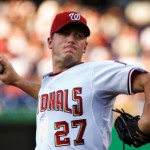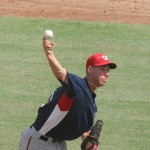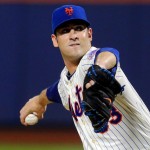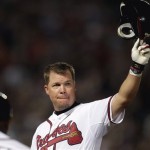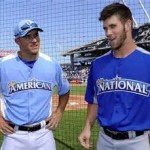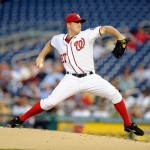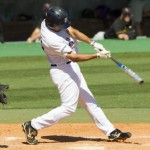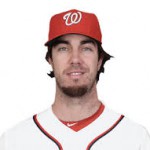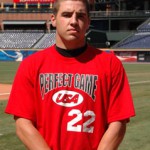[Editor’s note: duh, I published this with the wrong title; just fixed 8/2/13]
Continuing a monthly series of look-backs at our starters (here’s Apr 2013, May 2013, June 2013, July2013 posts), here’s a monthly glance at how our rotation is doing from a Starting Pitching standpoint. As with previous posts, we’ll have “Grades” per outing, the team’s performance per opposing starter sliced and diced a few ways, and other per-starter stuff that I like to track.
MLB Rotation Per-Start Grades (click here for Nats overall season stats)
- Strasburg: A,C,F,B,A+,D
- Gonzalez: C+,A,A+,B,F-
- Zimmermann: C-,C,B,F-,D
- Haren: C-,A+,D,A
- Jordan: B-,C-,B,C+,A
- Ohlendorf: B long relief,A spot start
- Detwiler: B- -> D/L
Quick Summary: A month where we had a handful of really shocking blow-up starts. Gonzalez‘s 11 run debacle yesterday, Strasburg‘s 2 inning/7 run meltdown being the most shocking examples. Only rookie Taylor Jordan kept an even keel, never pitching that badly and only really pitching excellently in his last start (also, not coincidentally his first win). I will say it is good to see Dan Haren putting in some good-to-great starts; that may really help. Ross Ohlendorf‘s injury yesterday better not be serious; Jordan’s innings limit is fast, fast approaching.
Performance By Opponent Starting Pitcher Rotation Order Number
A look at the opposing team’s rotation ranked 1-5 in the order they’re appearing from opening day. This table changes at the all-star break and honestly must be taken with a grain of salt, since guys like Clayton Kershaw are now the “#3 starter” because their turns were skipped coming out of the all-star game.
| Starter # | Record | Opposing Starter in Wins | Opposing Starter in Losses |
| 1 | 2-3 | Gallardo, Burnett | Hamels, Nolaso, Sanchez |
| 2 | 2-3 | Lee, Slowey | Peralta, Greinke, Verlander |
| 3 | 1-4 | Harvey | Lohse, Kendrick, Kershaw, Liriano |
| 4 | 2-1 | Marquis, Gee | Cole |
| 5 | 2-3 | Hand, Torres | Lannan, Fernandez, Morton |
| 5+ | 2-2 | Cashner, Erlin | Eovaldi, Mejia |
Quick thoughts: given the aforementioned caveat of having Justin Verlander listed as a #2 and Kershaw listed as a #3, the team more or less performed as you’d expect. A 1-4 record against opposing teams’ #3 starters is really skewed by the likes of Harvey, Lohse, Kershaw and Liriano in that grouping, all four guys being their team’s current aces. This table is becoming less and less meaningful as rotations get scattered as the season goes along.
Performance By Opponent Starting Pitcher Actual Performance Rank Intra-Rotation
A ranking of opposing teams’ rotations by pure performance at the time of the series, using ERA+ heavily.
| Starter # | Record | Opposing Starter in Wins | Opposing Starter in Losses |
| 1 | 3-4 | Lee, Harvey, Cashner | Sanchez, Lohse, Kershaw, Fernandez |
| 2 | 1-2 | Hand | Kendrik, Liriano |
| 3 | 4-2 | Gallardo, Burnett, Marquis, Gee | Greinke, Eovaldi |
| 4 | 1-4 | Erlin | Nolasco, Peralta, Verlander, Morton |
| 5 | 2-2 | Slowey, Torrez | Hamels, Cole |
| 5+ | 0-2 | Lannan, Mejia |
Quick Thoughts: the Nats actually held their own very well against other teams’ best performing guys. They hung losses on Matt Harvey somehow, and hung a loss on Cliff Lee. Less impressive was the collapse against AAA-callup Jenrry Mejia or the no-show against former teammmate John Lannan.
Performance By Opponent Starting Pitcher League-wide “Rank”
A team-independent assignment of a league-wide “rank” of what the starter is. Is he an “Ace?” Is he a #2?
| Starter # | Record | Opposing Starter in Wins | Opposing Starter in Losses |
| 1 | 2-4 | Harvey, Lee | Kershaw, Grienke, Verlander, Hamels |
| 2 | 0-3 | Sanchez, Liriano, Fernandez | |
| 3 | 2-3 | Gallardo, Burnett | Lohse, Nolasco, Cole |
| 4 | 0-1 | Kendrick | |
| 5 | 6-4 | Cashner, Hand, Marquis, Gee, Erlin, Slowey | Eovaldi, Peralta, Morton, Lannan |
| 5+ | 1-1 | Torres | Mejia |
Quick thoughts: despite a supposedly “weak” schedule the team faced a lot of big-time names in July. Six of the 27 games went against league-wide Aces, a tall order for any team. They also got whitewashed by the near-Aces/#2 starters, losing all three games against these types. More disappointing? Only a 6-4 record against league-wide #5 pitchers, the kind of guys that are nearly interchangeable with AAA players. Maybe John Lannan isn’t really a #5 starter (probably not; he’s probably more of a #4), but the rest of these guys?
Records by Pitching Advantage
Start-by-start advantages in my own opinion and then looking at the results.
| Wash | 4-6 | Zim-Gallardo, Gio-Cashner, Zim-Marquis, Stras-Erlin | Det-Lohse, Stras-Nolasco, Zim-Kendrick, Stras-Eovaldi, Stras-Peralta, Zim-Mejia |
| Even | 3-3 | Gio-Burnett, Jordan-Hand, Jordan-Torres | Gio-Verlander, Stras-Sanchez, Stras-Liriano |
| Opp | 4-8 | Jordan-Slowey, Ohlendorf-Harvey, Haren-Gee, Gio-Lee | Zimm-Kershaw, Gio-Greinke, Haren-Fernandez, Jordan-Hamels, Haren-Lannan, Jordan-Cole, Haren-Morton |
A sign of how our season has gone: I gave opponents the clear advantage in 12 of our 27 games this month. Compare this to April, when I only gave our opponents the advantage in TWO of our first 27 games. We’re to the point where Haren and Jordan are automatically underdogs nearly every time they take the mound, and we face enough power arms where our big three may not always be favored to win either.
Matchup analysis
Looking at the opposing starter rank that our guys are going up against to see how their competition fares.
| Nats Starters Opponents | matchup analysis | Nats Record under starter | |
| Strasburg | Two #2s, a #3 and three #5s | 1-5 | |
| Gonzalez | Three Aces, a #3 and a #5 | 3-2 | |
| Zimmermann | An Ace, a #3, a #4 and two #5s | 2-3 | |
| Haren | one #2, three #5s | 1-3 | |
| Detwiler | one #3 | 0-1 | |
| Jordan | An Ace, a #3 and three #5s | 3-2 | |
| Ohlendorf | An Ace in Harvey | 1-0 | |
Instead of classifying by rotation order in this table, this is by “league wide rank.” And we see some very interesting information.
- The team was only 1-5 in Strasburg’s 6 starts this month, and he wasn’t exactly going against an all-star collection of opposing starters. That’s a big-time area of concern. It all comes down to run support.
- Gio meanwhile had to face up with three of the best 20 pitchers in the league and still managed to have a winning record during his starts.
- Zimmermann, as we see in his grades, tailed off badly this month.
- Haren, despite facing off mostly against other #5 quality guys, still conspired to lose 3 of his four starts.
- Jordan, as we all know, has really surprised everyone and has been helping the team win.
- Ohlendorf faced off against one of (if not the) major’s best hurlers and the team got a win in his spot start.
